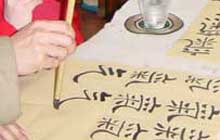
 According to ancient lore, when a Chinese man named Cangjie learned the divine secret of writing, the spirits were so angry that millet rained from heaven.
According to ancient lore, when a Chinese man named Cangjie learned the divine secret of writing, the spirits were so angry that millet rained from heaven.
Perhaps this was because one of the first applications of the Chinese pictograph system was in the practice of divination. This long-standing association between pictographs and the occultforces of nature helps explain the historic and continuing importance the Chinese people attach to writing and to the art of calligraphy.
On a par with painting, the art of calligraphy has gone through a long evolution resulting in the development of various styles and schools. It is generally divided into five scripts: the seal script ( zhuanshu ), the official or clerical script ( lishu ), the regular script ( kaishu ), the grass script ( caoshu ) and the running script ( xingshu ).
Zhuanshu (seal script) is the most archaic, and can be seen on oracle bones (used for divination) dating back to the Shang and Zhou dynasties (14th century-476 BC). Because of its long, developmental history however, there was great regional variation in its characters. In the above illustration for example, there are 40 different versions of the same auspicious character, shou (longevity).
L ishu (official script) was developed during the Qin dynasty (221-207 BC) in an attempt to standardize writing throughout the empire. This script can be seen on many stone inscriptions of the period. Kaishu (regular script) of which the oldest extant example dates soon after to the Wei Kingdom (220-265 AD), simplified the lishu . Its characters are the closest to the modern form, being square and architectural in style.
On the basis of the kaishu (regular script), the caoshu (grass script) was developed to allow for a quicker, more fluid style of writing. The final style, or xingshu (running script), lies somewhere between the kaishu (regular) and caoshu (grass) scripts in that at times the strokes are controlled and regular and at other times free and flowing. These are the three scripts most frequently used in modern times – master calligraphers compare them to a person standing (kaishu ), walking (xingshu ) and running (caoshu ).
An individual's writing is considered sufficiantly crucial that children are trained from a young age to perfect their writing technique. It is thought that a person's character and refinement can be gleaned from her style, the finest scripts being infused with the writer's vital, creative energy. Thus, calligraphic strokes will often be described in such organic terms as the 'bone', 'flesh', 'muscle' and 'blood' or with reference to such natural forces as 'rolling waves', 'leaping dragon', 'playful butterfly' or 'dewdrop about to fall'.